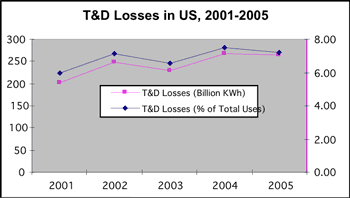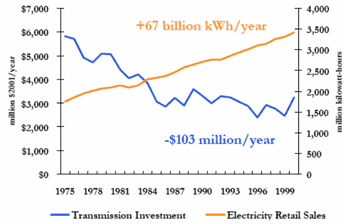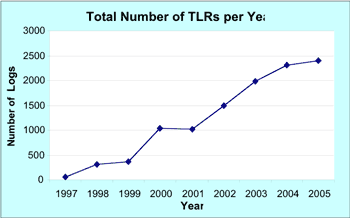Energy Efficiency in the Power Grid
The concept of energy efficiency has moved in and out of favor with the public over the years, but recently has gained renewed broad-based support. The confluence of economic, environmental and geopolitical concerns around reducing America's exposure to disruptions in the supply of energy has moved efficiency to the fore. As a result, along with renewable energy legislation, a number of initiatives are now underway in the U.S. to improve efficiency in a variety of areas, but much more can and should be done.
Improving transmission capacity is also
vital to the integration of renewables like wind and solar which are
often located far from the loads they must serve. For that reason,
the cause of efficiency in the T&D system is in perfect alignment
with that of expanding renewable generation. As renewable energy
technologies continue to grow in importance, the potential impact of
energy efficiency cannot be overstated.
However, other generation sources like wind and hydro power use the mechanical energy of moving masses of air or water to produce electric energy. Still other devices, such as fuel cells, use chemical reactions to generate electric energy. In all of these cases, though, some of the input energy is lost in the process.
The efficiency of generation varies widely with the technology used. In a traditional coal plant, for example, only about 30-35% of the energy in the coal ends up as electricity on the other end of the generator. So-called "supercritical" coal plants can reach efficiency levels in the mid-40's, and the latest coal technology, known as integrated gasification combined cycle or IGCC, is capable of efficiency levels above 60%. The most efficient gas-fired generators achieve a similar level of efficiency.
In renewable generation, efficiency is less of an issue for the simple reason that "fuels" like wind and sunlight are essentially inexhaustible and free. A typical wind turbine, for example, might achieve 45% efficiency in converting the physical force of the wind into electric power.
Obviously, though, even at 60% efficiency there is a tremendous amount of energy left behind in the generation process. That represents a higher cost of production for the generator, as well as a substantial waste of limited resources. There is, therefore, tremendous economic and ecological incentive to improve the efficiency of power generation so that more of the energy content of the input fuel is carried through to the output electricity.
Transmission & Distribution
The transmission and distribution, or "T&D" system includes
everything between a generation plant and an end-use site, i.e. a
residential home or commercial business. Along the way, some of
the energy supplied by the generator is lost due to the resistance
of the wires and equipment that the electricity passes through.
Most of this energy is converted to heat. Just how much energy is
taken up as losses in the T&D system depends greatly on the
physical characteristics of the system in question as well as how
it is operated. Generally speaking, T&D losses between 6% and 8%
are considered normal.

Source: Energy Information Administration
It is possible to calculate what this means in dollar terms by looking at the difference between the amount of electric energy generated and the amount actually sold at the retail level. According to data from the Energy Information Administration, net generation in the US came to over 3.9 billion megawatt hours (MWh) in 2005 while retail power sales during that year were about 3.6 billion MWh. T&D losses amounted to 239 million MWh, or 6.1% of net generation. Multiplying that number by the national average retail price of electricity for 2005, we can estimate those losses came at a cost to the US economy of just under $19.5 billion.
Congestion charges represent another significant cost of inefficiency in the T&D system, but are only partially determined by the physical characteristics of the grid. Congestion occurs when the scheduled or actual flows of electricity are restricted either by physical capacity constraints on a particular device or by operational safety constraints designed to preserve grid reliability. In order to meet demand, the system operator must find an alternative source of power that avoids the bottleneck. That alternative generator will be less economical, and therefore less efficient from a market perspective. A more robust T&D system, then, can provide a level, congestion-free playing field on which generators can compete.

Transmission Investment vs. Retail Electricity Sales
Source: IEEE
The California Independent System Operator reported congestion costs of $1.1 billion in 2004, $670 million in 2005, and $476 million in 2006. It's worth noting that the ISO attributes much of the reduction in the '04-'05 period to critical expansions on the state's "Path 15" north-south transmission corridor. Similarly, the PJM interconnection, which serves the largest territory of any regional transmission organization in the US, reported congestion costs of $750 million in 2004, $2 billion in 2005, and $1.6 billion in 2006. PJM notes that since 2002, congestion costs have come in at 7-10% of annual total billings.
As these figures make clear, the cost of inefficiency in the T&D system is significant. However, the impact of congestion is not limited to the cost associated with dispatching less economical generation. Often the situation requires grid operators to curtail service to consumers in some areas to protect the integrity of the grid as a whole. These "transmission loading relief" actions (TLRs) have increased dramatically in recent years, up nearly 150% just in the 2001-2005 period.

Source: NERC
Clearly too there is an inference to be drawn from these numbers about the relationship between efficiency in the T&D system and the reliability of that system. In every region of the US, for example, there are generation plants designated by the local grid operator as "reliability must-run" or RMR. These units are run regardless of their economic merit because their output is needed to maintain voltage levels.
RMR units are often older, dirtier and less efficient than modern plants, due to the fact that they tend to be located in urban areas where siting new plants is all but impossible. There are alternatives to RMR generators, but our current reliance on them can be viewed as a byproduct of a less-than-optimal T&D system.
Benefits of Improved Efficiency
The "business case" for energy efficiency is fairly
straightforward: using less energy means paying less for energy.
But a simple cost-benefit analysis might overlook some very
important benefits that efficiency brings.
At this point, there is little doubt that regulation of carbon dioxide is coming, with the power sector as a primary target. While there are technologies both available and in development to mitigate CO2 emissions from power plants, the fact remains that the easiest ton of CO2 to remove from the atmosphere is the one that is not emitted in the first place. Greater energy efficiency in the T&D system means lower emissions in generation to deliver the same amount of consumed energy.
Greater efficiency also has a direct impact on the role of renewables, specifically in terms of the percentage of the total fuel mix they account for. Lowering the amount of energy consumed (or lost) effectively increases the share of renewables in the total, assuming the gains are offset by reducing the amount of energy produced from traditional generation sources.
Fuel conservation and diversity is another strong selling point for efficiency, and here the benefits extend well beyond economic and even environmental considerations. Reducing US dependence on foreign fuel supplies—be they oil, natural gas or even coal—pays obvious dividends from a security standpoint, and the less we use, the less we have to buy.
Finally, within the context of the power system itself, it's important to recognize how interrelated energy efficiency is with grid reliability. In many areas of the US, transmission constraints have reached the point where they not only cost consumers billions of dollars in congestion charges, they threaten the integrity of the power system itself. Over the past twenty years, the situation has continued to deteriorate to the point where now the question of installing a new line is nearly moot in some locations. By the time it was completed, demand would long since have outstripped the ability of the local grid to meet it, so a short-term solution must be implemented in the interim.
Improving transmission capacity is also vital to the integration of renewables like wind and solar which are often located far from the loads they must serve. For that reason, the cause of efficiency in the T&D system is in perfect alignment with that of expanding renewable generation. As renewable energy technologies continue to grow in importance, the potential impact of energy efficiency cannot be overstated. With the array of technologies and methodologies now available, efficiency stands ready to play a much larger role in the energy equation.
Bob Fesmire is a communications manager working in ABB's power technology business. He writes frequently on power system technology, grid reliability and efficiency, and transmission issues as well as other topics.
The information and views expressed in this article are those of the author and not necessarily those of RenewableEnergyAccess.com or the companies that advertise on its Web site and other publications.
 To subscribe or visit go to:
http://www.renewableenergyaccess.com
To subscribe or visit go to:
http://www.renewableenergyaccess.com